Study of Full-duplex Communication in Satellite Networks
VerifiedAdded on 2022/08/17
|11
|1935
|18
AI Summary
Contribute Materials
Your contribution can guide someone’s learning journey. Share your
documents today.
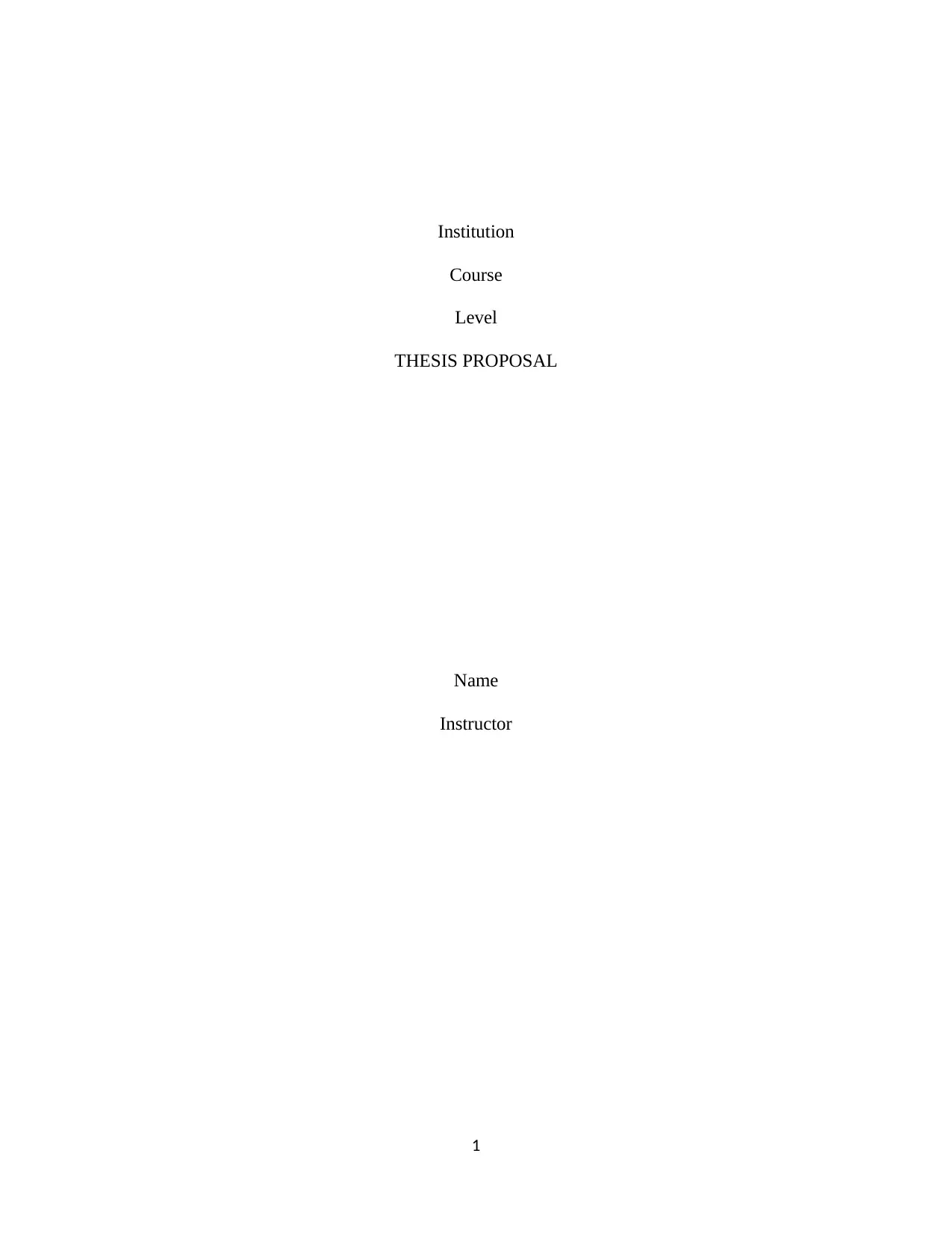
Institution
Course
Level
THESIS PROPOSAL
Name
Instructor
1
Course
Level
THESIS PROPOSAL
Name
Instructor
1
Secure Best Marks with AI Grader
Need help grading? Try our AI Grader for instant feedback on your assignments.
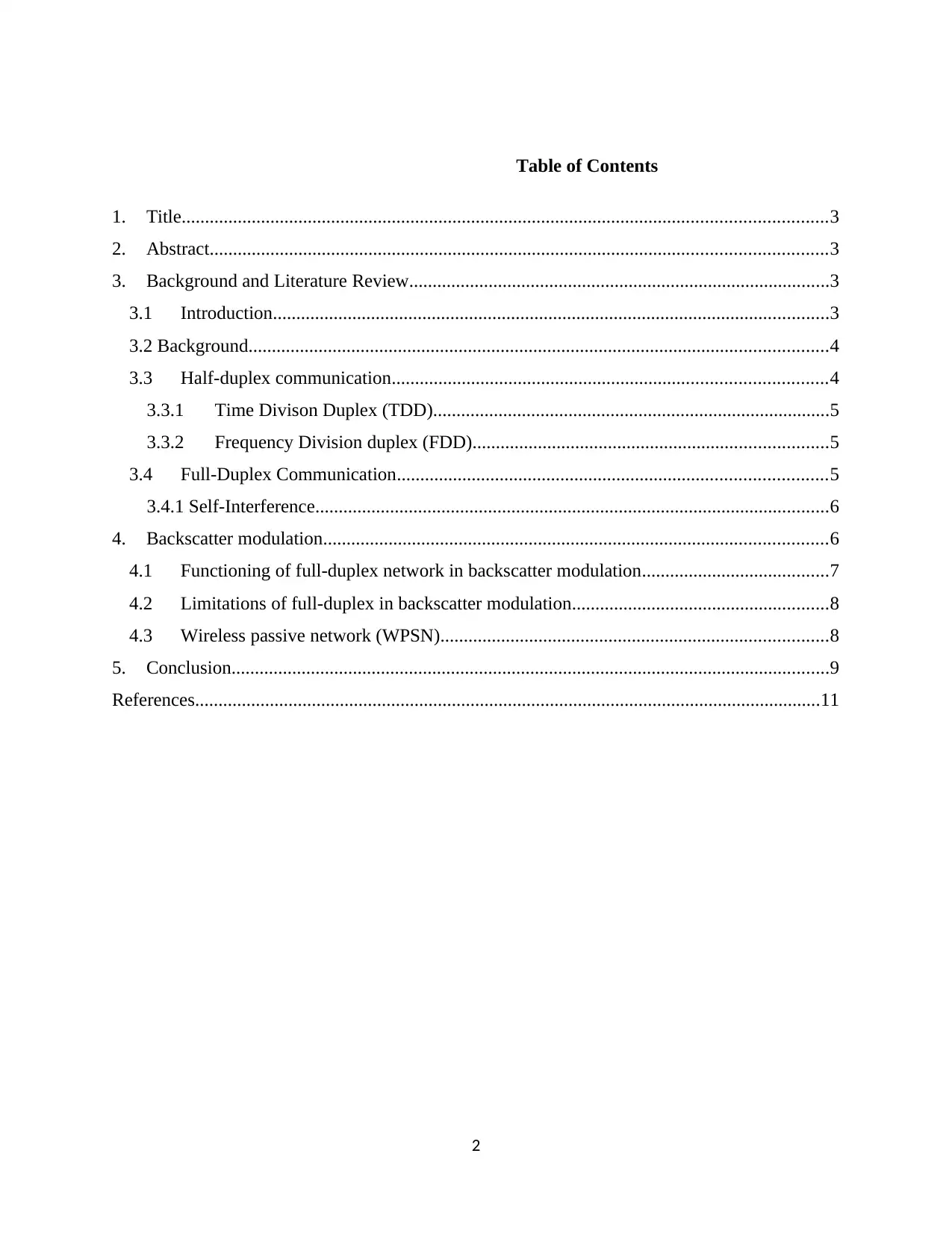
Table of Contents
1. Title..........................................................................................................................................3
2. Abstract....................................................................................................................................3
3. Background and Literature Review..........................................................................................3
3.1 Introduction.......................................................................................................................3
3.2 Background............................................................................................................................4
3.3 Half-duplex communication.............................................................................................4
3.3.1 Time Divison Duplex (TDD).....................................................................................5
3.3.2 Frequency Division duplex (FDD)............................................................................5
3.4 Full-Duplex Communication............................................................................................5
3.4.1 Self-Interference..............................................................................................................6
4. Backscatter modulation............................................................................................................6
4.1 Functioning of full-duplex network in backscatter modulation........................................7
4.2 Limitations of full-duplex in backscatter modulation.......................................................8
4.3 Wireless passive network (WPSN)...................................................................................8
5. Conclusion................................................................................................................................9
References......................................................................................................................................11
2
1. Title..........................................................................................................................................3
2. Abstract....................................................................................................................................3
3. Background and Literature Review..........................................................................................3
3.1 Introduction.......................................................................................................................3
3.2 Background............................................................................................................................4
3.3 Half-duplex communication.............................................................................................4
3.3.1 Time Divison Duplex (TDD).....................................................................................5
3.3.2 Frequency Division duplex (FDD)............................................................................5
3.4 Full-Duplex Communication............................................................................................5
3.4.1 Self-Interference..............................................................................................................6
4. Backscatter modulation............................................................................................................6
4.1 Functioning of full-duplex network in backscatter modulation........................................7
4.2 Limitations of full-duplex in backscatter modulation.......................................................8
4.3 Wireless passive network (WPSN)...................................................................................8
5. Conclusion................................................................................................................................9
References......................................................................................................................................11
2
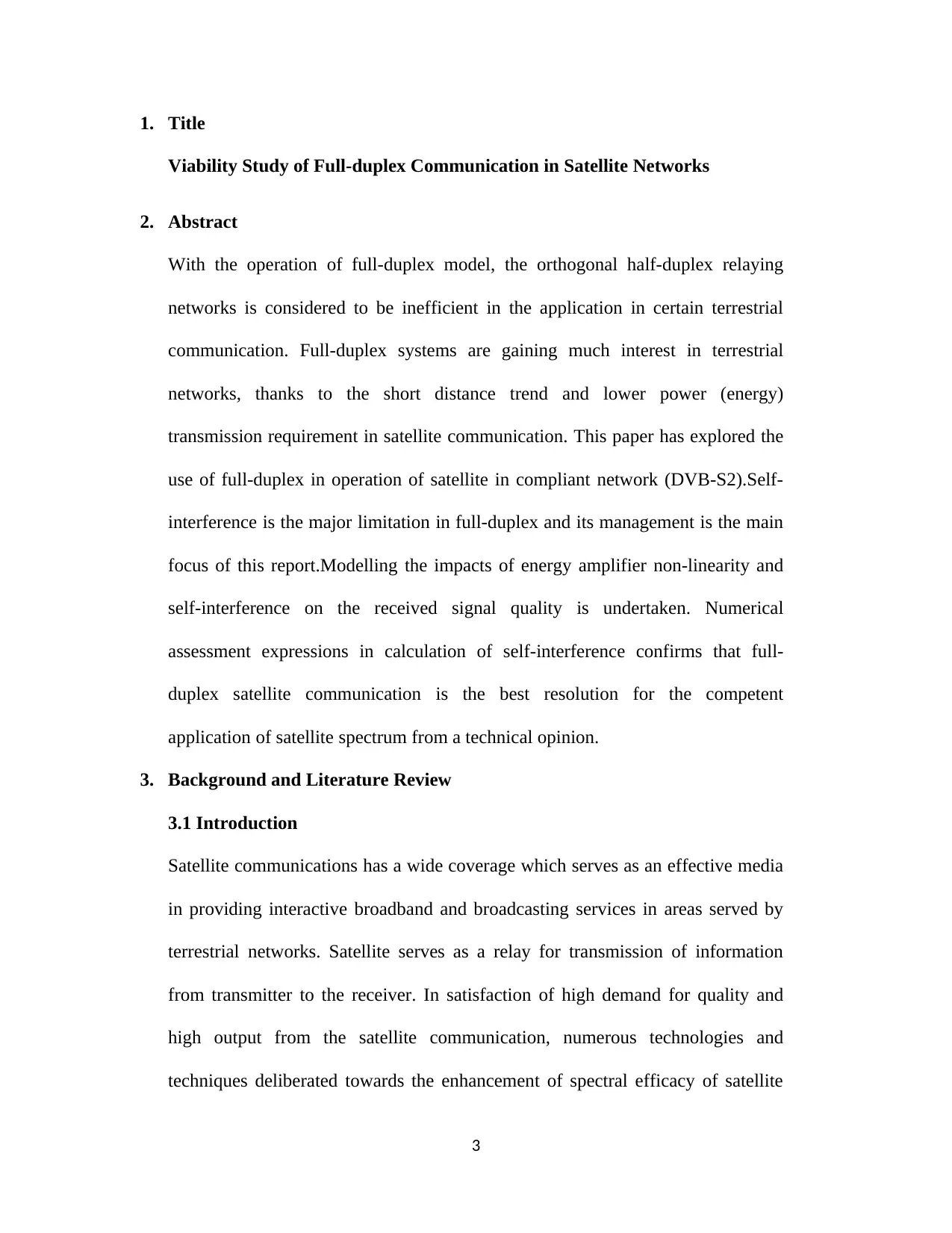
1. Title
Viability Study of Full-duplex Communication in Satellite Networks
2. Abstract
With the operation of full-duplex model, the orthogonal half-duplex relaying
networks is considered to be inefficient in the application in certain terrestrial
communication. Full-duplex systems are gaining much interest in terrestrial
networks, thanks to the short distance trend and lower power (energy)
transmission requirement in satellite communication. This paper has explored the
use of full-duplex in operation of satellite in compliant network (DVB-S2).Self-
interference is the major limitation in full-duplex and its management is the main
focus of this report.Modelling the impacts of energy amplifier non-linearity and
self-interference on the received signal quality is undertaken. Numerical
assessment expressions in calculation of self-interference confirms that full-
duplex satellite communication is the best resolution for the competent
application of satellite spectrum from a technical opinion.
3. Background and Literature Review
3.1 Introduction
Satellite communications has a wide coverage which serves as an effective media
in providing interactive broadband and broadcasting services in areas served by
terrestrial networks. Satellite serves as a relay for transmission of information
from transmitter to the receiver. In satisfaction of high demand for quality and
high output from the satellite communication, numerous technologies and
techniques deliberated towards the enhancement of spectral efficacy of satellite
3
Viability Study of Full-duplex Communication in Satellite Networks
2. Abstract
With the operation of full-duplex model, the orthogonal half-duplex relaying
networks is considered to be inefficient in the application in certain terrestrial
communication. Full-duplex systems are gaining much interest in terrestrial
networks, thanks to the short distance trend and lower power (energy)
transmission requirement in satellite communication. This paper has explored the
use of full-duplex in operation of satellite in compliant network (DVB-S2).Self-
interference is the major limitation in full-duplex and its management is the main
focus of this report.Modelling the impacts of energy amplifier non-linearity and
self-interference on the received signal quality is undertaken. Numerical
assessment expressions in calculation of self-interference confirms that full-
duplex satellite communication is the best resolution for the competent
application of satellite spectrum from a technical opinion.
3. Background and Literature Review
3.1 Introduction
Satellite communications has a wide coverage which serves as an effective media
in providing interactive broadband and broadcasting services in areas served by
terrestrial networks. Satellite serves as a relay for transmission of information
from transmitter to the receiver. In satisfaction of high demand for quality and
high output from the satellite communication, numerous technologies and
techniques deliberated towards the enhancement of spectral efficacy of satellite
3
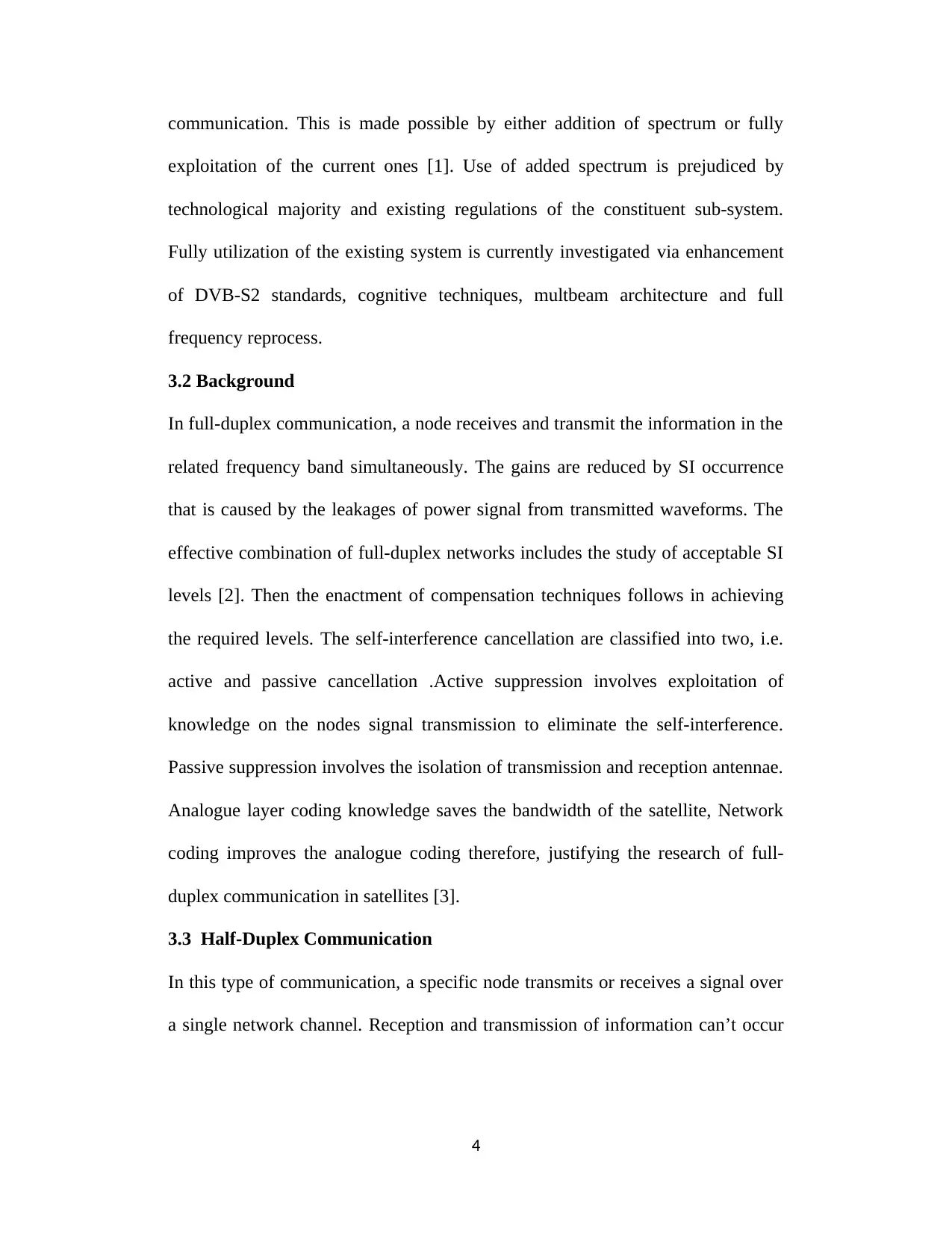
communication. This is made possible by either addition of spectrum or fully
exploitation of the current ones [1]. Use of added spectrum is prejudiced by
technological majority and existing regulations of the constituent sub-system.
Fully utilization of the existing system is currently investigated via enhancement
of DVB-S2 standards, cognitive techniques, multbeam architecture and full
frequency reprocess.
3.2 Background
In full-duplex communication, a node receives and transmit the information in the
related frequency band simultaneously. The gains are reduced by SI occurrence
that is caused by the leakages of power signal from transmitted waveforms. The
effective combination of full-duplex networks includes the study of acceptable SI
levels [2]. Then the enactment of compensation techniques follows in achieving
the required levels. The self-interference cancellation are classified into two, i.e.
active and passive cancellation .Active suppression involves exploitation of
knowledge on the nodes signal transmission to eliminate the self-interference.
Passive suppression involves the isolation of transmission and reception antennae.
Analogue layer coding knowledge saves the bandwidth of the satellite, Network
coding improves the analogue coding therefore, justifying the research of full-
duplex communication in satellites [3].
3.3 Half-Duplex Communication
In this type of communication, a specific node transmits or receives a signal over
a single network channel. Reception and transmission of information can’t occur
4
exploitation of the current ones [1]. Use of added spectrum is prejudiced by
technological majority and existing regulations of the constituent sub-system.
Fully utilization of the existing system is currently investigated via enhancement
of DVB-S2 standards, cognitive techniques, multbeam architecture and full
frequency reprocess.
3.2 Background
In full-duplex communication, a node receives and transmit the information in the
related frequency band simultaneously. The gains are reduced by SI occurrence
that is caused by the leakages of power signal from transmitted waveforms. The
effective combination of full-duplex networks includes the study of acceptable SI
levels [2]. Then the enactment of compensation techniques follows in achieving
the required levels. The self-interference cancellation are classified into two, i.e.
active and passive cancellation .Active suppression involves exploitation of
knowledge on the nodes signal transmission to eliminate the self-interference.
Passive suppression involves the isolation of transmission and reception antennae.
Analogue layer coding knowledge saves the bandwidth of the satellite, Network
coding improves the analogue coding therefore, justifying the research of full-
duplex communication in satellites [3].
3.3 Half-Duplex Communication
In this type of communication, a specific node transmits or receives a signal over
a single network channel. Reception and transmission of information can’t occur
4
Secure Best Marks with AI Grader
Need help grading? Try our AI Grader for instant feedback on your assignments.

simultaneously at same channel or time. Half–duplex network is achieved by
Time division or frequency division duplexing.
3.3.1 Time Division Duplex (TDD)
Transmission and reception the system occurs in one channel. Single channels are
used for downlink and uplink and it is divided into two time slots for transmission
and reception. The system bandwidth is availed to single user in a given time,
resulting to underutization of the bandwidth.
3.3.2 Frequency Division duplex (FDD)
Communication in this system occurs on 2 different channels where 2 dissimilar
frequencies used for downlink and uplink. Transmission and reception occurs
simultaneously at same period. For a 2-way network, 4 diverse frequencies are
used for receiving and transmitting the signal.
Fig 1. Half-duplex communication [4]
3.4 Full-Duplex Communication
Full-duplex in recent past was restricted to calculation which was almost difficult.
Due to technology improvement in electronic equipment and techniques, now the
system is practically feasible. The node can be used to convey and receive signal
at a uniform frequency channel and time, resulting to increased performance, cost
5
Time division or frequency division duplexing.
3.3.1 Time Division Duplex (TDD)
Transmission and reception the system occurs in one channel. Single channels are
used for downlink and uplink and it is divided into two time slots for transmission
and reception. The system bandwidth is availed to single user in a given time,
resulting to underutization of the bandwidth.
3.3.2 Frequency Division duplex (FDD)
Communication in this system occurs on 2 different channels where 2 dissimilar
frequencies used for downlink and uplink. Transmission and reception occurs
simultaneously at same period. For a 2-way network, 4 diverse frequencies are
used for receiving and transmitting the signal.
Fig 1. Half-duplex communication [4]
3.4 Full-Duplex Communication
Full-duplex in recent past was restricted to calculation which was almost difficult.
Due to technology improvement in electronic equipment and techniques, now the
system is practically feasible. The node can be used to convey and receive signal
at a uniform frequency channel and time, resulting to increased performance, cost
5

efficient and proper bandwidth utilization. The key limitation of this type of
communication systems is self-interferences.
Figure 2.Full-duplex communication [5]
3.4.1 Self-Interference
This is the major limitation in the practical operation of full-duplex
communication. When a given node receive and transmit signal simultaneously,
the node experiences interferences caused by receiving signal. Basically, when a
node is involved in transmission and reception of the signal at the same period,
power leakages arises due to concurrently reception of signal. Due to this
problem, enactment of full-duplex system is not practically achievable. Self–
interferences can be reduced by use of the following methods:
a. Variation of antennae direction.
b. Cross polarization method
c. Logical location of reception and transmission antenna.
d. Physical separation of receiving and transmitting antenna.
e. Deduction of estimated value of self- interference from the received
signal.
4. Backscatter modulation
6
communication systems is self-interferences.
Figure 2.Full-duplex communication [5]
3.4.1 Self-Interference
This is the major limitation in the practical operation of full-duplex
communication. When a given node receive and transmit signal simultaneously,
the node experiences interferences caused by receiving signal. Basically, when a
node is involved in transmission and reception of the signal at the same period,
power leakages arises due to concurrently reception of signal. Due to this
problem, enactment of full-duplex system is not practically achievable. Self–
interferences can be reduced by use of the following methods:
a. Variation of antennae direction.
b. Cross polarization method
c. Logical location of reception and transmission antenna.
d. Physical separation of receiving and transmitting antenna.
e. Deduction of estimated value of self- interference from the received
signal.
4. Backscatter modulation
6
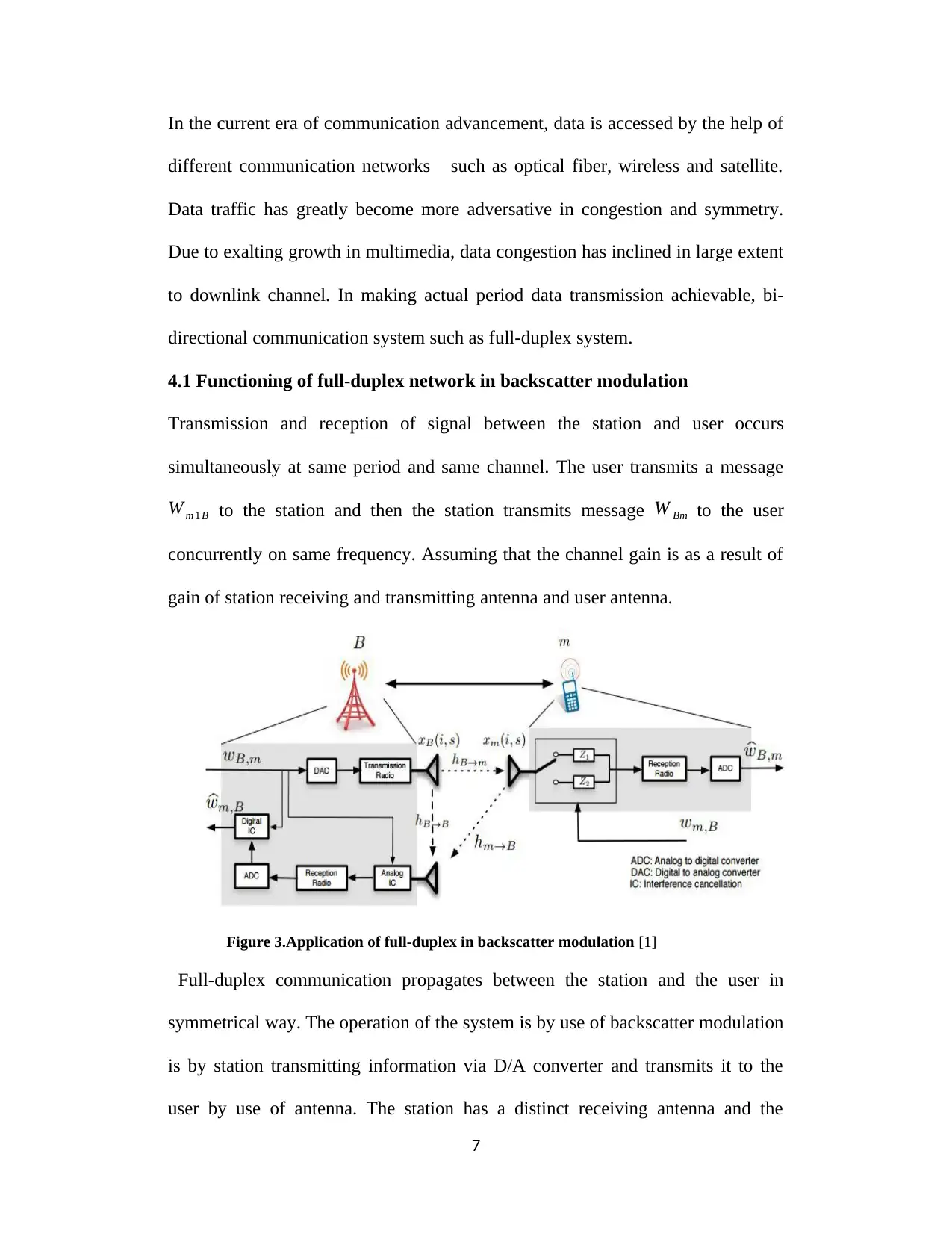
In the current era of communication advancement, data is accessed by the help of
different communication networks such as optical fiber, wireless and satellite.
Data traffic has greatly become more adversative in congestion and symmetry.
Due to exalting growth in multimedia, data congestion has inclined in large extent
to downlink channel. In making actual period data transmission achievable, bi-
directional communication system such as full-duplex system.
4.1 Functioning of full-duplex network in backscatter modulation
Transmission and reception of signal between the station and user occurs
simultaneously at same period and same channel. The user transmits a message
W m 1 B to the station and then the station transmits message W Bm to the user
concurrently on same frequency. Assuming that the channel gain is as a result of
gain of station receiving and transmitting antenna and user antenna.
Figure 3.Application of full-duplex in backscatter modulation [1]
Full-duplex communication propagates between the station and the user in
symmetrical way. The operation of the system is by use of backscatter modulation
is by station transmitting information via D/A converter and transmits it to the
user by use of antenna. The station has a distinct receiving antenna and the
7
different communication networks such as optical fiber, wireless and satellite.
Data traffic has greatly become more adversative in congestion and symmetry.
Due to exalting growth in multimedia, data congestion has inclined in large extent
to downlink channel. In making actual period data transmission achievable, bi-
directional communication system such as full-duplex system.
4.1 Functioning of full-duplex network in backscatter modulation
Transmission and reception of signal between the station and user occurs
simultaneously at same period and same channel. The user transmits a message
W m 1 B to the station and then the station transmits message W Bm to the user
concurrently on same frequency. Assuming that the channel gain is as a result of
gain of station receiving and transmitting antenna and user antenna.
Figure 3.Application of full-duplex in backscatter modulation [1]
Full-duplex communication propagates between the station and the user in
symmetrical way. The operation of the system is by use of backscatter modulation
is by station transmitting information via D/A converter and transmits it to the
user by use of antenna. The station has a distinct receiving antenna and the
7
Paraphrase This Document
Need a fresh take? Get an instant paraphrase of this document with our AI Paraphraser
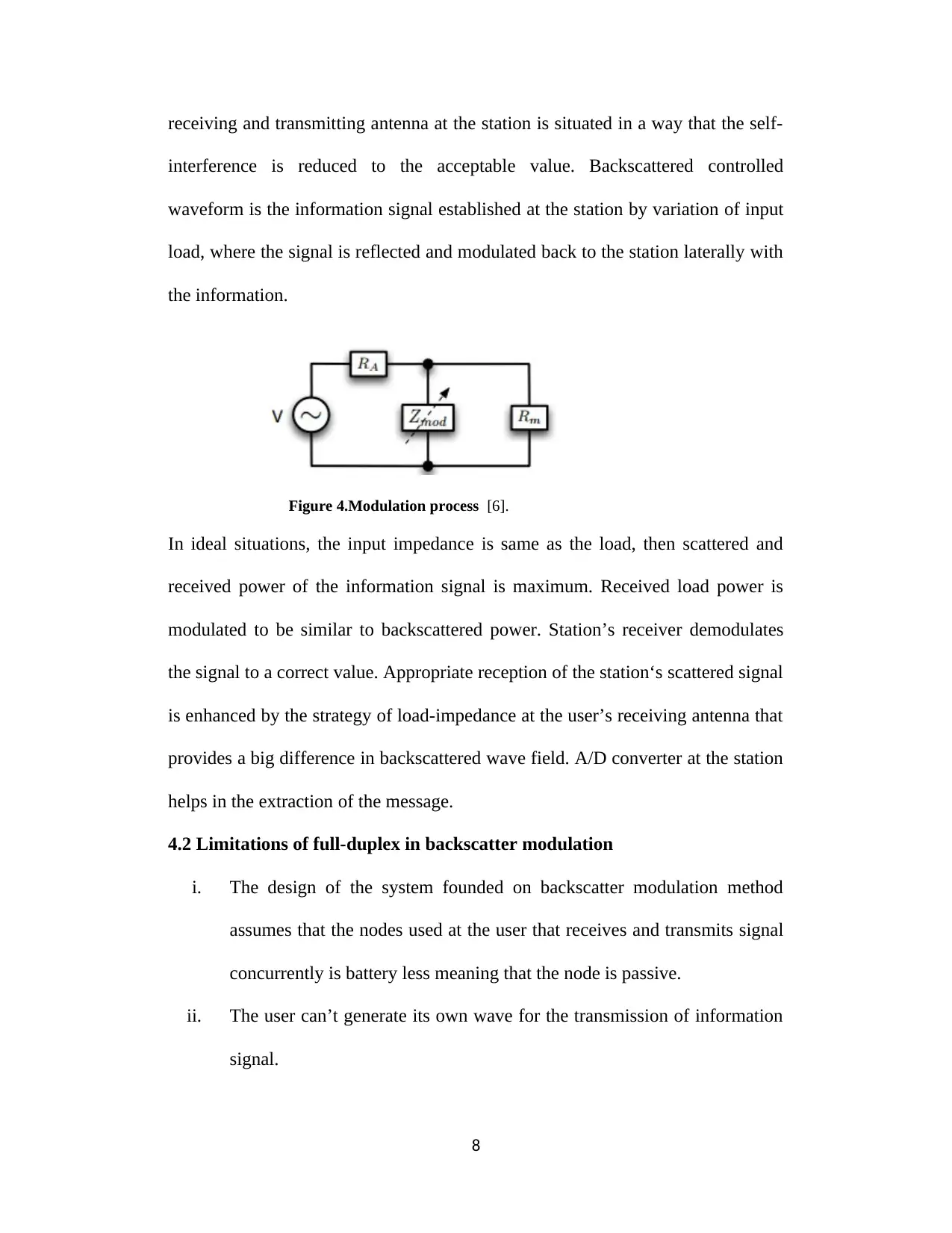
receiving and transmitting antenna at the station is situated in a way that the self-
interference is reduced to the acceptable value. Backscattered controlled
waveform is the information signal established at the station by variation of input
load, where the signal is reflected and modulated back to the station laterally with
the information.
Figure 4.Modulation process [6].
In ideal situations, the input impedance is same as the load, then scattered and
received power of the information signal is maximum. Received load power is
modulated to be similar to backscattered power. Station’s receiver demodulates
the signal to a correct value. Appropriate reception of the station‘s scattered signal
is enhanced by the strategy of load-impedance at the user’s receiving antenna that
provides a big difference in backscattered wave field. A/D converter at the station
helps in the extraction of the message.
4.2 Limitations of full-duplex in backscatter modulation
i. The design of the system founded on backscatter modulation method
assumes that the nodes used at the user that receives and transmits signal
concurrently is battery less meaning that the node is passive.
ii. The user can’t generate its own wave for the transmission of information
signal.
8
interference is reduced to the acceptable value. Backscattered controlled
waveform is the information signal established at the station by variation of input
load, where the signal is reflected and modulated back to the station laterally with
the information.
Figure 4.Modulation process [6].
In ideal situations, the input impedance is same as the load, then scattered and
received power of the information signal is maximum. Received load power is
modulated to be similar to backscattered power. Station’s receiver demodulates
the signal to a correct value. Appropriate reception of the station‘s scattered signal
is enhanced by the strategy of load-impedance at the user’s receiving antenna that
provides a big difference in backscattered wave field. A/D converter at the station
helps in the extraction of the message.
4.2 Limitations of full-duplex in backscatter modulation
i. The design of the system founded on backscatter modulation method
assumes that the nodes used at the user that receives and transmits signal
concurrently is battery less meaning that the node is passive.
ii. The user can’t generate its own wave for the transmission of information
signal.
8
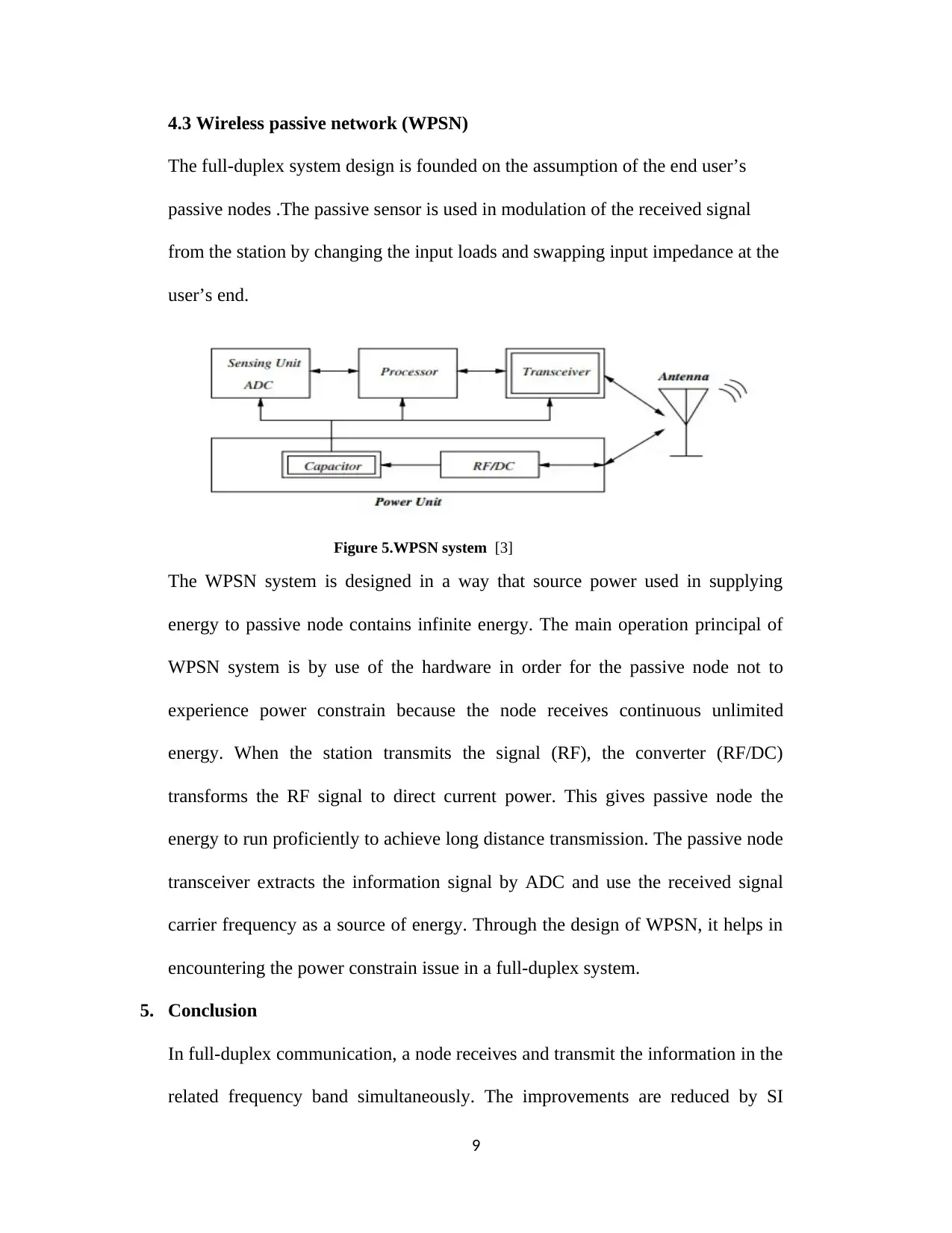
4.3 Wireless passive network (WPSN)
The full-duplex system design is founded on the assumption of the end user’s
passive nodes .The passive sensor is used in modulation of the received signal
from the station by changing the input loads and swapping input impedance at the
user’s end.
Figure 5.WPSN system [3]
The WPSN system is designed in a way that source power used in supplying
energy to passive node contains infinite energy. The main operation principal of
WPSN system is by use of the hardware in order for the passive node not to
experience power constrain because the node receives continuous unlimited
energy. When the station transmits the signal (RF), the converter (RF/DC)
transforms the RF signal to direct current power. This gives passive node the
energy to run proficiently to achieve long distance transmission. The passive node
transceiver extracts the information signal by ADC and use the received signal
carrier frequency as a source of energy. Through the design of WPSN, it helps in
encountering the power constrain issue in a full-duplex system.
5. Conclusion
In full-duplex communication, a node receives and transmit the information in the
related frequency band simultaneously. The improvements are reduced by SI
9
The full-duplex system design is founded on the assumption of the end user’s
passive nodes .The passive sensor is used in modulation of the received signal
from the station by changing the input loads and swapping input impedance at the
user’s end.
Figure 5.WPSN system [3]
The WPSN system is designed in a way that source power used in supplying
energy to passive node contains infinite energy. The main operation principal of
WPSN system is by use of the hardware in order for the passive node not to
experience power constrain because the node receives continuous unlimited
energy. When the station transmits the signal (RF), the converter (RF/DC)
transforms the RF signal to direct current power. This gives passive node the
energy to run proficiently to achieve long distance transmission. The passive node
transceiver extracts the information signal by ADC and use the received signal
carrier frequency as a source of energy. Through the design of WPSN, it helps in
encountering the power constrain issue in a full-duplex system.
5. Conclusion
In full-duplex communication, a node receives and transmit the information in the
related frequency band simultaneously. The improvements are reduced by SI
9
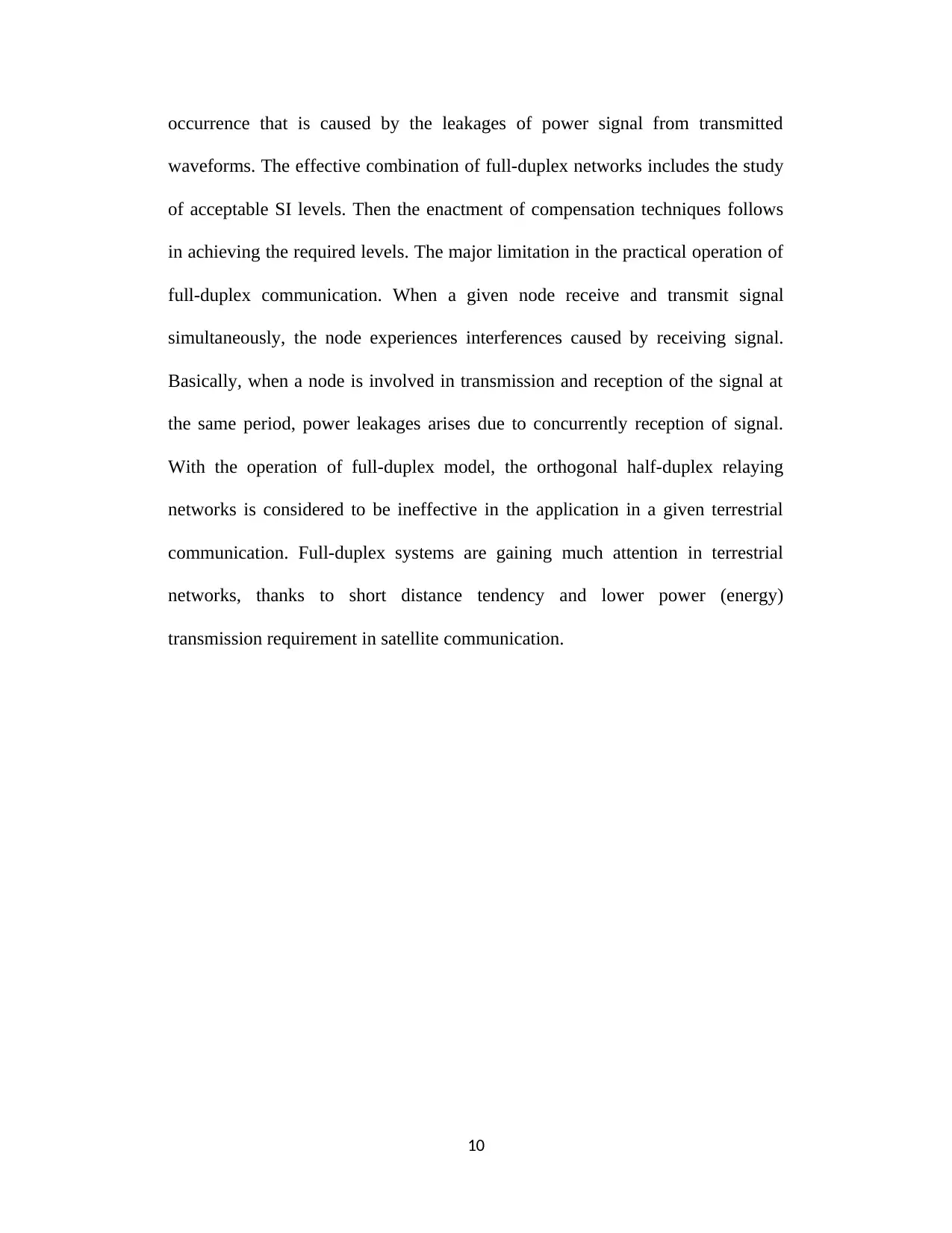
occurrence that is caused by the leakages of power signal from transmitted
waveforms. The effective combination of full-duplex networks includes the study
of acceptable SI levels. Then the enactment of compensation techniques follows
in achieving the required levels. The major limitation in the practical operation of
full-duplex communication. When a given node receive and transmit signal
simultaneously, the node experiences interferences caused by receiving signal.
Basically, when a node is involved in transmission and reception of the signal at
the same period, power leakages arises due to concurrently reception of signal.
With the operation of full-duplex model, the orthogonal half-duplex relaying
networks is considered to be ineffective in the application in a given terrestrial
communication. Full-duplex systems are gaining much attention in terrestrial
networks, thanks to short distance tendency and lower power (energy)
transmission requirement in satellite communication.
10
waveforms. The effective combination of full-duplex networks includes the study
of acceptable SI levels. Then the enactment of compensation techniques follows
in achieving the required levels. The major limitation in the practical operation of
full-duplex communication. When a given node receive and transmit signal
simultaneously, the node experiences interferences caused by receiving signal.
Basically, when a node is involved in transmission and reception of the signal at
the same period, power leakages arises due to concurrently reception of signal.
With the operation of full-duplex model, the orthogonal half-duplex relaying
networks is considered to be ineffective in the application in a given terrestrial
communication. Full-duplex systems are gaining much attention in terrestrial
networks, thanks to short distance tendency and lower power (energy)
transmission requirement in satellite communication.
10
Secure Best Marks with AI Grader
Need help grading? Try our AI Grader for instant feedback on your assignments.

References
[1] M. J. K. S. P. L. a. S. K. J. I. Choi, "Achieving single channel, full duplex wireless
communication," ACM International Conference on Mobile Computing and Networking, no.
16, pp. 1-12, 2010.
[2] B. &. I. S. Smida, "Full-duplex wireless communication based on backscatter amplifier,"
IEEE International Conference on Communications Workshops, no. 1, p. 91–95, 2014.
[3] A. R. M. D. W. B. a. P. S. B. P. Day, "Full-duplex MIMO relaying: achievable rates under
limited dynamic range," IEEE J. Select. Areas Commun, vol. 30, no. 8, pp. 1541-1553, 2012.
[4] A. S. a. A. S. E. Everett, "Passive self-interference suppression for FD infrastructure nodes,"
IEEE Trans. Wireless Commun, vol. 13, no. 2, p. 680–694, 2014.
[5] E. M. a. S. K. D. Bharadia, "Full duplex radios," ACM Special Interest Group on Data
Communication (SIGCOMM), p. 375–386, 2013.
[6] M. R. B. S. a. B. O. R. Piazza, "Data Predistortion for Multicarrier Satellite Channels Based
on Direct Learning," IEEE Trans. Signal Proc, vol. 62, no. 22, pp. 5868-5880, 2014.
11
[1] M. J. K. S. P. L. a. S. K. J. I. Choi, "Achieving single channel, full duplex wireless
communication," ACM International Conference on Mobile Computing and Networking, no.
16, pp. 1-12, 2010.
[2] B. &. I. S. Smida, "Full-duplex wireless communication based on backscatter amplifier,"
IEEE International Conference on Communications Workshops, no. 1, p. 91–95, 2014.
[3] A. R. M. D. W. B. a. P. S. B. P. Day, "Full-duplex MIMO relaying: achievable rates under
limited dynamic range," IEEE J. Select. Areas Commun, vol. 30, no. 8, pp. 1541-1553, 2012.
[4] A. S. a. A. S. E. Everett, "Passive self-interference suppression for FD infrastructure nodes,"
IEEE Trans. Wireless Commun, vol. 13, no. 2, p. 680–694, 2014.
[5] E. M. a. S. K. D. Bharadia, "Full duplex radios," ACM Special Interest Group on Data
Communication (SIGCOMM), p. 375–386, 2013.
[6] M. R. B. S. a. B. O. R. Piazza, "Data Predistortion for Multicarrier Satellite Channels Based
on Direct Learning," IEEE Trans. Signal Proc, vol. 62, no. 22, pp. 5868-5880, 2014.
11
1 out of 11
Related Documents
Your All-in-One AI-Powered Toolkit for Academic Success.
+13062052269
info@desklib.com
Available 24*7 on WhatsApp / Email
![[object Object]](/_next/static/media/star-bottom.7253800d.svg)
Unlock your academic potential
© 2024 | Zucol Services PVT LTD | All rights reserved.





